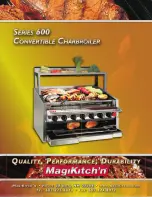
43
LP- 293 REV. 9.2.14
PART 6 – GAS PIPING
FAILURE TO FOLLOW ALL PRECAUTIONS IN THIS SECTION
COULD RESULT IN FIRE, EXPLOSION, OR DEATH!
A. GAS CONNECTION
The gas supply shall have a maximum inlet pressure of less than 14"
w.c. (3.5 kPa), and a minimum of 3.5" w.c. (.87 kPa). The entire
piping system, gas meter and regulator must be sized properly to
prevent pressure drop greater than 0.5" (.12 kPa) as stated in the
National Fuel Gas Code. This information is listed on the rating label.
It is very important that you are con
nected to the type of gas noted on the rating plate. “LP” for liquefied petroleum, propane gas, or
“NAT” for natural or city gas. You must not do a gas conversion without an approved gas conversion kit. Prior to turning the gas on, all
gas connections must be approved by the local gas supplier or utility, in addition to the governing authority.
A gas conversion kit comes with the boiler. Follow the included instructions VERY carefully. Failure to follow gas conversion instructions
could result in property damage, serious injury, or death.
The gas valve and blower will not support the weight of gas piping. Do not attempt to support the weight of piping with the boiler or its
accessories. Failure to follow this warning could result in gas leakage, substantial property damage, severe personal injury, or death.
The gas connection on the boiler
is 3/4” for the EL-80/110/150
and 1” for the EL-220/299/301/399. It is mandatory that this
fitting is used for connection to a field fabricated drip leg as
shown in the illustration above per the National Fuel Gas Code.
You must ensure that the entire gas line to the connection at
the boiler is no smaller than the unit supplied connection.
Once all inspections have been performed, the piping must be
leak tested. If the leak test requirement is a higher test pres-
sure than the maximum inlet pressure, you must isolate the
boiler from the gas line. In order to do this, shut the gas off
using factory and field-installed gas cocks. This will prevent
high pressure. Failure to do so may damage the gas valve. In
the event the gas valve is exposed to a pressure greater than
½ PSI, 14" w.c., or 3.5 kPa, the gas valve must be replaced.
Never use an open flame (match, lighter, etc.) to check gas
connections.
B. GAS PIPING
1. Run the gas supply line in accordance with all applicable codes.
2. Locate and install manual shutoff valves in accordance with state and local requirements.
3. In Canada, the Manual Shutoff must be identified by the installing contractor.
4. It is important to support gas piping as the unit is not designed to structurally support a large amount of weight.
5. Purge all gas lines thoroughly to avoid start up issues with air in the lines.
6. Sealing compound must be approved for gas connections. Care must be taken when applying compound to prevent blockage or
obstruction of gas flow which may affect the operation of the unit.
Figure 22
Table 14
– Gas Pipe Sizing / BTU’s per Hour
Summary of Contents for EL-110
Page 13: ...13 LP 293 REV 9 2 14 Figure 3 LP 285 B ...
Page 51: ...51 LP 293 REV 9 2 14 Figure 29 Cascade Master and Follower ...
Page 52: ...52 LP 293 REV 9 2 14 Figure 30 ...
Page 53: ...53 LP 293 REV 9 2 14 Figure 31 ...
Page 54: ...54 LP 293 REV 9 2 14 Figure 32 ...
Page 77: ...77 LP 293 REV 9 2 14 Figure 36 ...
Page 78: ...78 LP 293 REV 9 2 14 Figure 37 ...
Page 79: ...79 LP 293 REV 9 2 14 Figure 38 LP 293 A ...
Page 82: ...82 LP 293 REV 9 2 14 ...
Page 83: ...83 LP 293 REV 9 2 14 ...
















































